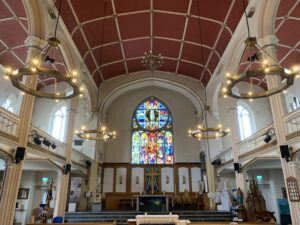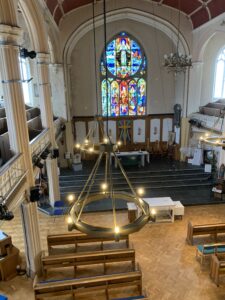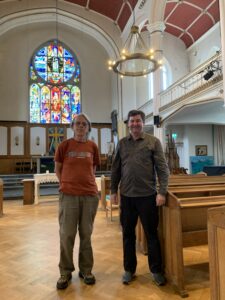Clergy use Halos to help cut carbon
Churchgoers in Penzance won’t need to worry about feeling chilly during services this autumn thanks to new Halo heaters.
The Herschel Halo radiant heaters, costing more than £69,000, have been installed in St Mary’s ready for the cooler months – and will help cut the church’s carbon footprint too.
Church members raised £43,187 towards the cost of the halo infrared heaters and then given £36,527 from the Demonstrator Project – comprising of £21,286 Archbishop’s Council and £15,241 Benefact Trust.
These halo heaters, which have candle-style bulbs to create a chandelier effect, will help church officials make a saving on energy costs and help towards their goal of reducing carbon.
Ben Wood, Cut Carbon Support Officer (Churches), said: “It’s fantastic to see such an impressive achievement from St Mary’s Penzance. This has been a major undertaking both in time and resources, but they are committed both to keeping the congregation warm and ensuring the church is Net Zero in line with the Church of England’s target of achieving Net Zero by 2030.
“We were really pleased to be able to put St Mary’s forward for the grant towards the heating system.”
Keno Toriello, administrator at Penlee Cluster of Churches, said the Halo heating blends in well with the historic building style.
Keno said: “St Mary’s is committed to reducing its carbon footprint so when our gas heating failed, we sought a greener alternative.
“Many people have remarked on how attractive the halos are and how they look as if they have always been there.”
“We have yet to test the heating in the colder months of the year, but people find it creates a comfortable environment.
“As a worshipping community we are pleased to have our church warm and welcoming to all who come to share in our worship and in our daily life as a church family.”
and in our daily life as a church family.”
Abi Hiscock, NZ Demonstrator Churches Project and Grant Manager, says: “I’m so thrilled to see another Demonstrator Church lead the way to reaching net zero carbon.
“In fact, the Church of England has St Mary’s Penzance’s passion for net zero to thank for our ambitious target to reach net zero by 2030 by moving synod to adopt this date. And they have been true to this challenge, even as a medieval grade II* listed building.
“By installing beautiful Herschel Halo radiant heaters, and removing their failed gas boiler heating system, and switching to a green energy provider, this church has reduced their carbon emissions from 14.7 tonnes annually to near zero. This is a potential whopping 88.2 tonnes Co2 emission reduction by 2030.”
 Ben added: “St Mary’s has raised a huge amount of funds locally, but a key financial element has been the Demonstrator Project’s contribution. Remember – there might be contributory funding available to finance Net Zero improvements which can make your church warmer and lower your utility bills.
Ben added: “St Mary’s has raised a huge amount of funds locally, but a key financial element has been the Demonstrator Project’s contribution. Remember – there might be contributory funding available to finance Net Zero improvements which can make your church warmer and lower your utility bills.
“If you’re interested then please contact me at ben.wood@truro.anglican.org”
In February 2020, The Church of England brought forward its net zero emissions target to 2030, their Net Zero Carbon routemap can be viewed here.
About the Net Zero Demonstrator Church Fund:
The £5.2m Net Zero Demonstrator Church Fund was created after recognising unique financial, heritage and technical challenges faced by parish churches, managed by priests and volunteers – not capital works project managers or net zero mechanical engineers or heritage specialist architects.
The grant programme runs to the end of the year with the ambition to support 114 churches in achieving net zero with:
- Preparatory Grants up to £18,000 and technical support to aid in planning and fundraising.
- Capital Grants up to £50,000 (or 25% of total project cost) from the Net Zero Programme for implementing net zero solutions, supplemented by up to £36,000 (or 17.9% of project cost) from the Benefact Trust.
Information about this fund supplied by Abi Hiscock, NZ Demonstrator Churches Project and Grant Manager.

